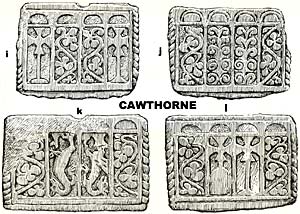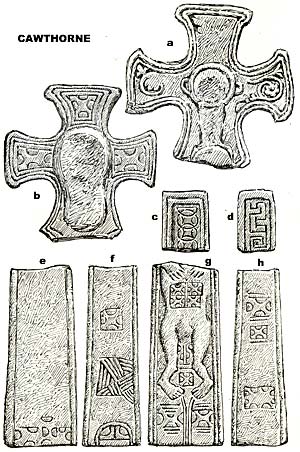|
CLICK TO ENLARGE
CLICK TO ENLARGE
CLICK TO ENLARGE


Taylor Hill
Cawthorne
Barnsley
South Yorkshire
S75 4HQ
Open every Saturday and Sunday from 2 to 4 PM
Group bookings at any time throughout the year by appointment.
Adult £1.00; Child (5-16yrs) Free.
Children under 16 must be accompanied by an adult.
|
CLICK TO ENLARGE
CLICK MAP TO ENLARGE
CLICK TO ENLARGE
The Beginning
The Cawthorne Museum Society was founded in 1884 by the Rev. Charles Tiplady Pratt who was vicar of the parish at the time. He encouraged the young people of the village to become interested in Natural History, and he formed groups to study and collect birds eggs, flowers (illegal to do so today), fossils, shells and grasses, and to study astronomy and the weather. These studies were helped by winter seasons of lectures - or "penny readings" as they were known by.
The collections were housed in an old cottage, one of two which stood on the site of the present building - the other being used as a meeting house for the Primitive Methodists. This little museum was open Saturday evenings - members free - non-members 1 penny admission and, according to the parish magazines of that date, must have been very popular.
The New Building
Very soon the collections of exhibits connected with the various study groups, together with curios and curiosities from the village and from those parts of the world visited by the local squire and his family of Cannon Hall, soon out grew the premises. The Rev. C.T. Pratt was a very forceful character, which reflects throughout his 50 odd years in the village, and he convinced Sir Walter Spencer Stanhope and his brother Roddam, that what Cawthorne needed was a purpose built museum.
Roddam was one of the pre Raphaelite Group of artists who lived most of the time in Florence for health reasons and he was very keen on the idea of a museum. He enlisted the aid of his friends, particularly John Ruskin, and the work was soon in hand demolishing the old cottages and laying the foundations of the new museum. The work was undertaken by the estate craftsmen when there was no other pressing work to be done on the Cannon Hall estate. They used stone and timbers from property demolished on the estate - a 13th century crook and later post and trusses. Craftsmen indeed they were, they had already completed in 1880 the restoration of the Parish Church in Cawthorne, and the building of a girl's school in the village some years earlier. The whole work of the museum took some two years to complete and the building was officially opened in October 1889 to scenes of great rejoicing, plus a public tea - White tickets at 5pm and Red tickets at 5.45pm. "It is requested that persons with Red tickets do not try to take tea at 5pm Rev. C.T. Pratt".
The Society continued to flourish and the 'penny readings' continue up to the present time - we have a record of over 105 years of winter lectures on a vast range of subjects from travel, collecting, local history, ethnography and the like.
Bought by the Villagers
In 1951, when Cannon Hall was sold to Barnsley for a museum, the Cannon Hall Estate offered the Cawthorne Victoria Jubilee Museum building to the village for the sum of £100. The money was raised with some difficulty, but upon completion it was matched by £100 from an anonymous donor, so the Society was on a firm footing.
The Collections continued to grow and when Mr. Noel Moxon, Secretary of the Society for 40 years, died, a gift of money from his family sowed the seeds for the need for an extension to the premises. This seed soon grew and the Trustees and Committee once again became fund raisers. Through grants and covenants, over £18,000 was raised for the cause in 18 months and the work went ahead. The new galleries are furnished and the displays are arranged very much in the same way as those in the older part of the building so that all looks in keeping.
The new extension was opened on 24th April 1983 by the Lord Bishop of Wakefield - The Right Reverend Colin James, and a tea was held for the parishioners in the Village Hall, just as had been done 100 years before at the original opening, but tickets were the same colour and everyone had tea at the same time!
The Collections
Original collections are still to be found in the museum. Butterflies and moths, birds and eggs, fossils, stuffed animals, paintings, domestic bygones, war time relics, old school books and memorabilia, a collection of souvenir china, bottles, a cheetah (stroked by many children over the years), a two headed lamb, a mongoose locked in deadly combat with a cobra, a 9 1/2 pound gall stone from a horse (we now know that horses do not have gall bladders, but we like to keep the story, and the stone is from a horses intestine), a figure of John Wesley made from a whale's vertebra, coins and medals, stereoscope, a man-trap, Victorian coffin bier - the list could go on.
The museum is a typical Victorian hotch potch and we wouldn't have it any other way. Whichever way you turn there is something to interest and catch your eye. A voluntary committee of sixteen villagers run the Museum and decide general policy. Their work is monitored by the body of Trustees and help with stewardship is given by some of the members of the Society. School parties are taken round the museum during the week and adult groups often visit, especially summer evenings when if requested we can arrange for the Church to be open for the visit.
In 1996 we were delighted to receive a grant from the Lottery Heritage for work consisting of refurbishment of timbers and stained glass at the front, ramp for the disabled plus a toilet and extension for workrooms, storage of artefacts needing attention and office space. We believe our museum is unique in that it is owned by the people of Cawthorne, administered on their behalf by eight trustees and is, as far we know, the only survivor of John Ruskin's dream of a network of village museums set up throughout Britain.
http://www.aboutbritain.com/CawthorneMuseum.htm
|